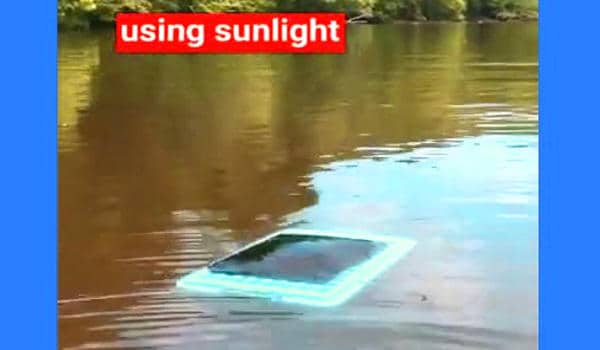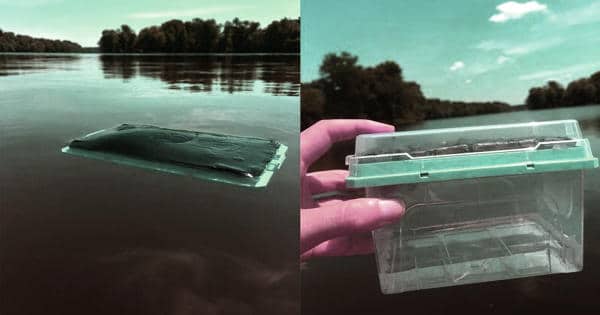A new water purification device powered solely by sunlight could contribute to the production of safe drinking water at a low cost and with minimal environmental impact. When placed in contaminated water, the gel absorbs only pure water and leaves the contaminants behind. When the gel is warmed by the sun, it changes shape and expel water for collection.
The device resembles a large sponge that absorbs water while leaving contaminants such as lead, oil, and pathogens behind. Simply place the sponge in sunlight to collect the purified water. The device was described in detail by the researchers in a paper published this week in the journal Advanced Materials.
The pufferfish, a species that takes in water to swell its body when threatened and then releases water when the threat passes, inspired the device, according to co-inventor Rodney Priestley, the Pomeroy and Betty Perry Smith Professor of Chemical and Biological Engineering and Princeton’s vice dean for innovation.
A new invention that uses sunlight to drive water purification could help solve the problem of providing clean water off the grid.
“The most exciting aspect of this work to me is that it can operate completely off-grid, at both large and small scales,” Priestley said. “It could also work in the developed world at locations that require low-cost, non-powered water purification.”
The gel material at the heart of the device was developed by Xiaohui Xu, a Princeton Presidential Postdoctoral Research Fellow in the Department of Chemical and Biological Engineering and co-inventor. “Sunlight is free,” Xu explained, “and the materials used to make this device are low-cost and non-toxic, making this a cost-effective and environmentally friendly way to generate pure water.”
According to the authors, the technology has the highest passive solar water-purification rate of any competing technology. According to Xu, one way to use the gel is to place it in a water source in the evening and then place it in the sunlight the next day to generate the day’s drinking water.
Water contaminated with petroleum and other oils, heavy metals such as lead, small molecules, and pathogens such as yeast can be purified using the gel. The researchers demonstrated that the gel retains its ability to filter water for at least ten cycles of soaking and discharge with no discernible loss of performance. The findings indicate that the gel can be used repeatedly.

Xu took the device to Lake Carnegie on the Princeton University campus to demonstrate it in real-world conditions. Xu immersed the gel in the lake’s cool water (25 degrees Celsius, or 77 degrees Fahrenheit), which contains microorganisms that make it unsafe to drink, for an hour. Xu lifted the gel from the water and placed it on top of a container at the end of the hour. Over the next hour, as the sun warmed the gel, pure water trickled into the container.
According to the researchers, the device filters water much faster than existing passive solar-powered water purification methods. Most other solar-powered approaches use sunlight to evaporate water, which takes much longer than the new gel’s absorption and release. Other water filtration methods necessitate the use of electricity or another form of energy to pump water through a membrane. Passive filtration via gravity, like typical household countertop filters, necessitates regular filter replacement.
The new device is powered by a gel that changes color depending on temperature. At room temperature, the gel can absorb water and act as a sponge. When heated to 33 degrees Celsius (91 degrees Fahrenheit), the gel does the opposite, forcing water out of its pores.
The gel has a honeycomb-like structure that is extremely porous. A closer look reveals that the honeycomb is made up of long chains of repeating molecules called poly(N-isopropylacrylamide), which are cross-linked to form a mesh. Some regions of the mesh contain molecules that prefer to be near water, or are hydrophilic, while others are hydrophobic or repel water.
At room temperature, the chains are long and flexible, and water can easily flow into the material via capillary action to reach the water-loving regions. When the material is heated by the sun, the hydrophobic chains clump together and force the water out of the gel.
This gel is sandwiched between two other layers that prevent contaminants from reaching the inner gel. The middle layer is made of a dark-colored material called polydopamine, which converts sunlight into heat while also keeping heavy metals and organic molecules out. With PDA in place, the sun’s rays can heat up the inner material even if the outside temperature is not particularly warm. The final external layer is an alginate filtering layer that prevents pathogens and other materials from entering the gel.
One of the difficulties in creating the device, according to Xu, was formulating the inner gel to have the proper properties for water absorption. The gel was initially brittle, so she changed the composition until it was flexible. Coauthors Sehmus Ozden and Navid Bizmark, postdoctoral research associates at the Princeton Institute for the Science and Technology of Materials, assisted Xu in synthesizing the materials and conducting studies to evaluate the device’s ability to purify water.
Sujit Datta, an assistant professor of chemical and biological engineering, and Craig Arnold, the Susan Dod Brown Professor of Mechanical and Aerospace Engineering and director of the Princeton Institute for the Science and Technology of Materials, worked together on the technology’s development.
With the assistance of Princeton Innovation, the team is investigating ways to make the technology widely available. Princeton Innovation assists University researchers in the translation of discoveries into technologies and services for the benefit of society.
















